
Fish migration is mass relocation by fish from one area or body of water to another. Many types of fish migrate on a regular basis, on time scales ranging from daily to annually or longer, and over distances ranging from a few metres to thousands of kilometres. Such migrations are usually done for better feeding or to reproduce, but in other cases the reasons are unclear.
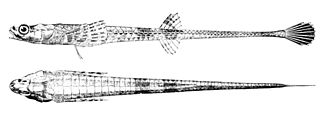
Agonidae is a family of small, bottom-dwelling, cold-water marine fish. Common names for members of this family include poachers, Irish lords, sea ravens, alligatorfishes, starsnouts, hooknoses, and rockheads. They are notable for having elongated bodies covered by scales modified into bony plates, and for using their large pectoral fins to move in short bursts. The family includes about 59 species in some 25 genera, some of which are quite widespread.

Sebastes norvegicus, the rose fish, ocean perch, Atlantic redfish, Norway haddock, golden redfish or pinkbelly rosefish, is a species of marine ray-finned fish belonging to the subfamily Sebastinae, the rockfishes, part of the family Scorpaenidae. It is found in the North Atlantic Ocean. It is a large, slow-growing, late-maturing fish and the subject of a fishery.
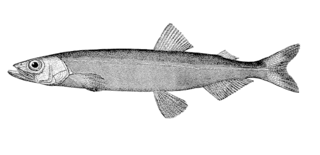
The capelin or caplin is a small forage fish of the smelt family found in the North Atlantic, North Pacific and Arctic oceans. In summer, it grazes on dense swarms of plankton at the edge of the ice shelf. Larger capelin also eat a great deal of krill and other crustaceans. Among others, whales, seals, Atlantic cod, Atlantic mackerel, squid and seabirds prey on capelin, in particular during the spawning season while the capelin migrate south. Capelin spawn on sand and gravel bottoms or sandy beaches at the age of two to six years. When spawning on beaches, capelin have an extremely high post-spawning mortality rate which, for males, is close to 100%. Males reach 20 cm (8 in) in length, while females are up to 25.2 cm (10 in) long. They are olive-coloured dorsally, shading to silver on sides. Males have a translucent ridge on both sides of their bodies. The ventral aspects of the males iridesce reddish at the time of spawn.

The Hemitripterinae is a subfamily of the scorpaeniform family Agonidae, known as sea ravens or sailfin sculpins. They are bottom-dwelling fish that feed on small invertebrates, found in the northwest Atlantic and north Pacific Oceans. They are covered in small spines.

The cabezon is a large species of sculpin native to the Pacific coast of North America. Although the genus name translates literally as "scorpion fish", true scorpionfish belong to the related family Scorpaenidae. The cabezon is the only known member of its genus.

"Under the Sea" is a song from Disney's 1989 animated film The Little Mermaid, composed by Alan Menken with lyrics by Howard Ashman. It is influenced by the calypso style of the Caribbean which originated in Trinidad and Tobago, as well as reggae, which originated in Jamaica. The song was performed in the film by Samuel E. Wright. The track won the Academy Award for Best Original Song in 1989, the first for a Disney film since "Chim Chim Cher-ee" from Mary Poppins in 1964. Additionally, the song won the Grammy Award for Best Song Written for Visual Media in 1991.

The Hawaiian Lanternshark is a species of small squaliform sharkin the family Etmopteridae.
Lithogenes is a genus of South American catfish of the family Loricariidae. It is the only genus within the subfamily Lithogeneinae.

Jaton hemitripterus is a species of sea snail, a marine gastropod mollusk in the family Muricidae, the murex snails or rock snails.
Jaton is a genus of sea snails, marine gastropod mollusks in the subfamily Ocenebrinae of the family Muricidae, the murex snails or rock snails.

Dikerogammarus villosus, also known as the killer shrimp, is a species of amphipod crustacean native to the Ponto-Caspian region of eastern Europe, but which has become invasive across the western part of the continent. In the areas it has invaded, it lives in a wide range of habitats and will prey on many other animals. It is fast-growing, reaching sexual maturity in 4–8 weeks. As it has moved through Europe, it threatens other species and has already displaced both native amphipods and previous invaders.
Anatoly Petrovich Andriyashev was a Soviet and Russian ichthyologist, marine biologist, and zoogeographist, notable for his studies of marine fauna of the Arctic and the Northern Pacific.

Hemitripterus is a genus of marine ray-finned fishes, sculpins, belonging to the subfamily Hemitripterinae which is part of the family Agonidae. These fishes are found in the North Pacific and Northwest Atlantic Oceans.
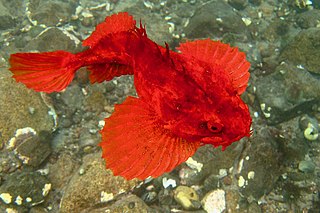
Hemitripterus americanus, the sea raven, is a species of marine ray-finned fish belonging to the subfamily Hemitripterinae of the family Agonidae. The sea raven is found along the Atlantic coast of North America.
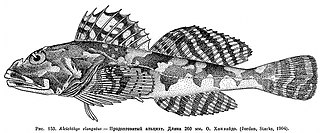
Alcichthys elongatus is a fish in the family Cottidae (sculpins), and the only valid member of its genus. It was described by Franz Steindachner in 1881. It is a marine, boreal fish which is known from the northwestern Pacific Ocean, including the Sea of Okhotsk and Japan. It dwells at a depth range of 15 to 269 m, and inhabits rocky reefs. Males can reach a maximum total length of 44 cm (17 in), but more commonly reach a TL of 31.5 cm (12.4 in). The maximum recorded weight is 1 kg (2.2 lb).

Dinogunellins are unusual toxic phospholipids found in the roe of some fishes, and is one of the best studied ichthyotoxin. These phospholipids could be found as a complex with non-toxic proteins like in the cabezon toxin or in the lipostichaerin.

Gaius is a genus of large mygalomorph spiders in the family Idiopidae. Erected in 1914 by William Joseph Rainbow, for much of its history the genus contained only one species, Gaius villosus. More species were added in 2018. All are endemic to Western Australia.
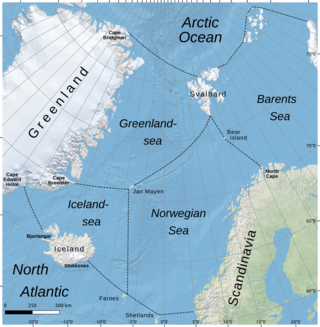
The Iceland Sea is a small body of water delimited by the Jan Mayen fracture zone to the north, Greenland to the west, the Denmark Strait to the south, and the Jan Mayen Ridge to the east. Depths usually range from 500 to 2,000 meters but can be shallower on the Continental shelf of East Greenland. The Kolbeinsey Ridge crosses the Iceland Sea, dividing it into eastern and western parts.

The bigmouth sculpin is a species of marine ray-finned fish belonging to the subfamily Hemitripterinae of the family Agonidae. This species is found in the northern Pacific Ocean from the Bering Sea and the Aleutian Islands south as far as Eureka, California.

















